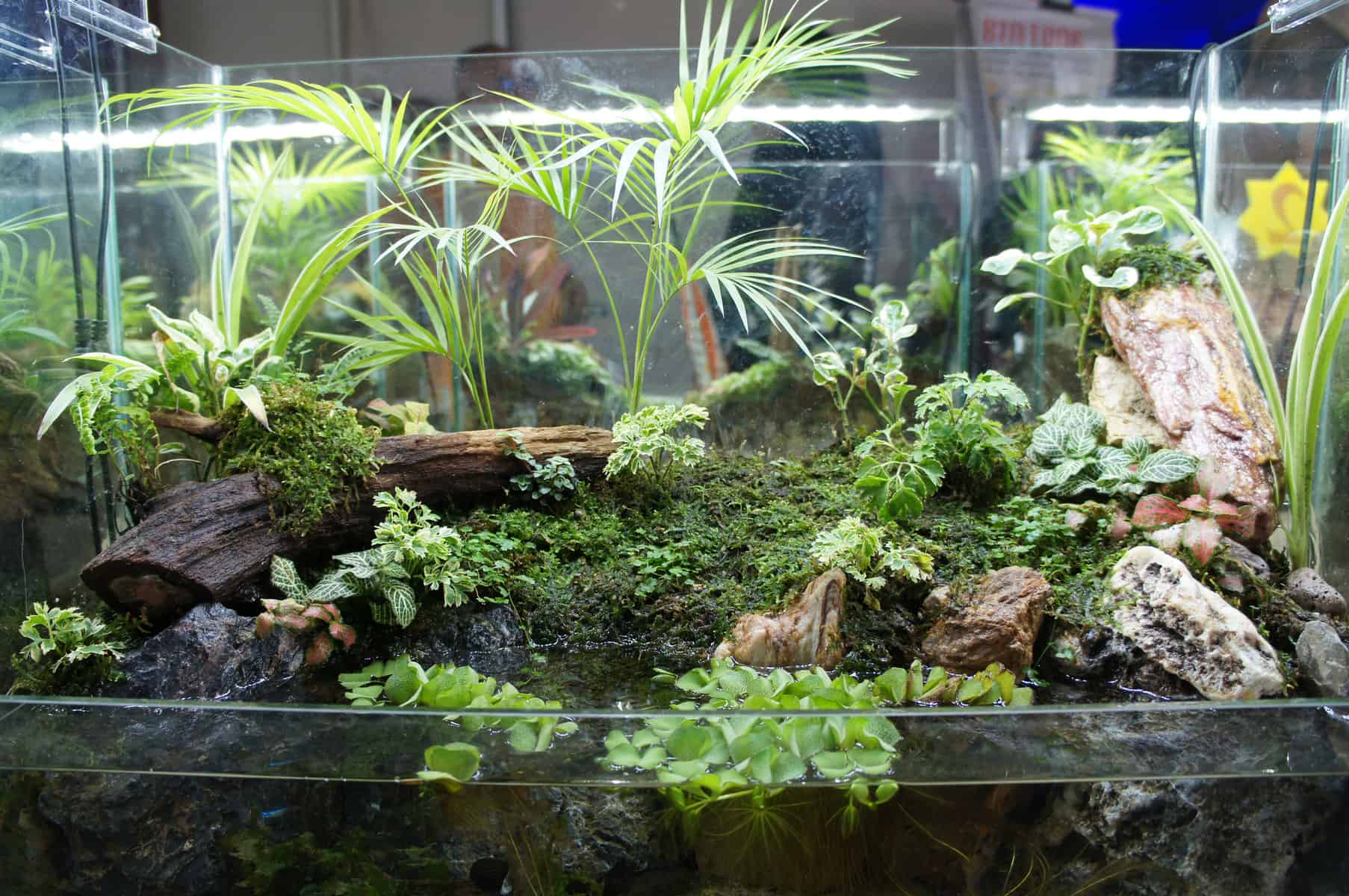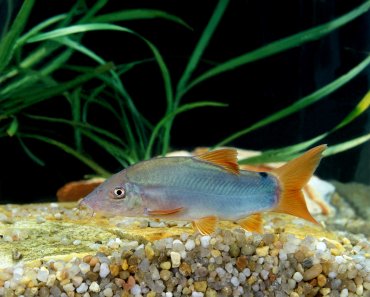Almost every college dorm windowsill or student apartment has at least one spider plant; mine certainly did!
Spider plants are easy to grow and very adaptable, happily growing in a wide range of conditions and environments. But can you grow a spider plant in your home aquarium?
The answer is yes, with a few caveats, you can grow a spider plant in your aquarium.
Read this guide to learn more about growing spider plants in your fish tank.
What Is a Spider plant?
The Spider plant is also commonly called Spider Ivy, Ribbon plant, and hen-and-chickens, but its scientific name is Chlorophytum comosum. The plant’s common name comes from its habit of producing small plantlets on long, trailing stems that look like spiders.
The plant puts out stems up to 2 feet long, sometimes producing a few small leaves, and when conditions are right, it will flower. If the flowers are pollinated, a capsule-type fruit is produced, containing a few flat, black seeds.
The plant is an evergreen species belonging to the family Asparagaceae that comes from tropical and southern Africa. Spider plants have also become naturalized in western Australia and Bangladesh.
Can I Grow a Spider Plant in My Aquarium?
So, can you grow a Spider plant in your fish tank?
The answer to that question is yes and no!
Spider plants cannot live underwater. So, if you completely submerge the plant, the leaves will quickly rot, and the plant will die.
However, you can grow these non-aquatic plants in your fish tank, provided that the foliage remains entirely above the water. Crucially, Spider plants don’t need to be rooted in soil to live.
How Can I Grow a Spider Plant in My Aquarium?
So, in theory, you can grow a Spider plant in a freshwater aquarium. Spider plants cannot survive in saltwater and are not suitable for life in a marine tank.
For your Spider plant to survive, it needs water, oxygen, light, and nutrients so that the plant can photosynthesize.
Water
As previously mentioned, Spider plants must have freshwater conditions in which to grow and cannot survive in saltwater.
A fish tank has a filtration system that agitates the water surface to provide plenty of dissolved oxygen for the fish. Plants can help to boost oxygen levels in the tank by using CO2 and giving off oxygen during photosynthesis.
Fertilizer
Fish tanks are equipped with a filtration system that keeps the water clean and processes substances, such as ammonia, nitrites, and nitrates, that are produced by decomposing fish poop, leftover fish food, and other organic waste.
Nitrates are very harmful to fish and can potentially kill them if the toxic substances are not removed from the water. However, aquatic plants utilize those substances as fertilizers.
Some hobbyists whose tanks contain lots of aquarium plants choose to supplement that by using root tabs or liquid fertilizer.
Lighting
Spider plants need moderate lighting conditions to grow, although a small amount of shade is tolerable. In fact, the fish tank environment, with its medium to low artificial lighting, suits the Spider plant better than keeping it on a windowsill in direct sunlight.
These plants don’t have a waxy coating to protect their leaves from sunlight, and the plant leaves can easily be scorched.
Temperature
Spider plants are extremely adaptable to various climate conditions, being able to tolerate temperatures as low as 65°F and up to 90°F.
So, you could grow a spider plant on the surface of a coldwater aquarium without too much trouble, and the humidity of a tropical tank would also suit this plant species.
Planting

The best way to grow a Spider plant in a regular fish tank is to float the plant directly in the water so that the roots are completely covered, but all the leaves remain exposed to the air and the light.
Don’t submerge the leaves below the waterline, or the plant will rot and die.
Pesticides
Although spider plants are not toxic to fish, many are raised in commercial horticultural greenhouses where they are treated with insecticides and pesticides.
Those chemicals can kill your fish and other livestock. So, if you decide to use a Spider plant in your fish tank, check with your supplier to ensure the plant is clean and free from pesticides and other chemicals.
Paludariums
If you keep a paludarium that includes both land and water features, you can include a Spider plant in the setup.
In a paludarium, you can plant rooted spider plant roots in damp soil, where they will grow much like other common house plants and aquarium plants.
What Are the Benefits of Growing Spider Plants in Your Aquarium?
The main benefit of Spider plant cultivation in fish tanks is that they are beautiful to look at.
You can choose from solid or variegated colored leaves to complement the look of your setup, and the plant’s emerged growth habit really draws the eye.
Frequently Asked Questions
Here are the answers to some of the most commonly asked questions about growing Spider plants in the aquarium.
Q: Can You Grow a Spider Plant in Water?
A: Yes, in theory, you can grow a Spider plant in water. In a fish tank, the plant will derive most of its nutritional requirements from the nitrates in the water and from the light it receives.
However, if you want to keep a Spider plant in your living room in a vase of water, you’ll need to provide it with some liquid fertilizer.
Q: Can Spider Plants Live Underwater?
A: In theory, a Spider plant could survive for a short time underwater. However, the plant leaves will quickly turn brown and will eventually rot.
Without leaves, the plant cannot photosynthesize, so it will die.
Q: How Do I Propagate Spider Plants?
A: Spider plant propagation is simple and quick. All you need to do is to remove the baby plantlets that grow at the end of the plant’s offshoots, and you have a brand-new plant.
To ensure the plantlets will survive, wait until the plants have at least five leaves and are two to three inches long before you snip them off.
Often, the plantlets produce their first roots while still attached to the mother plant. Remove the plantlet and put it in a small container of potting compost until the plant is established.
Q: Why Is My Spider Plant Turning Yellow?
A: The usual cause of Spider plant leaves turning yellow is a lack of light.
The plant’s leaves turn yellow because they cannot produce sufficient chlorophyll, which is what gives them their normal, vibrant green color.
If lack of light is not the problem, your plant’s leaves could turn yellow because the roots are rotting. That usually happens because the soil has become waterlogged due to overwatering.
Spider plants grown outside during the summer months can be attacked by pests, including mealy bugs, whiteflies, mites, and aphids. These pests basically suck the sap out of the plant, and that eventually causes the leaves to turn yellow.
You can usually fix that problem by washing the plant in horticulture soap and then rinsing the leaves well to remove all the bugs. Allow the plant to dry in a place with good air circulation, and double-check that all the bugs have gone.
Q: Why Is My Spider Plant Turning Brown?
There are several reasons why your Spider plant’s leaves are turning brown.
Too much exposure to direct sunlight causes the plant’s leaves to burn and turn brown and crispy. However, your fish tank should not be placed in direct sunlight, which causes hotspots, temperature fluctuations, and algal bloom.
It could be that the plant leaves are too close to your fish tank lights, which is turning the leaves brown.
Lack of humidity also causes Spider plant leaves to go brown. That shouldn’t be a problem if you grow your Spider plants in your fish tank or paludarium.
Too much fluoride in the water can accumulate in the plant’s leaves and inhibit photosynthesis. The toxicity that causes can turn the leaves brown. However, in a fish tank, the carbon element of the filtration system should remove fluoride and other chemical and heavy metals from the water.
Don’t go overboard when adding fertilizer to your fish tank water for your plants. Over-fertilizing your Spider plant will cause the leaf tips to go brown by damaging the plant’s roots and preventing the plant from taking up nutrients from the water.
Final Thoughts
Did you enjoy our guide to growing Spider plants in your aquarium? If you did, please take a moment to share the article before you go.
Spider plants are a common houseplant that many people have in their homes. But you can grow the plant in your fish tank or paludarium, too, provided you place the Spider plant foliage completely emerged.
This is a hardy plant that can tolerate a wide range of conditions and temperatures. The plant will grow in water, using the nutrients in your aquarium water, so you won’t need to worry about giving it plant food.
Do you have Spider plants in your fish tank? Tell us in the comments box below.





![[Giveaway] Yummy Combs Dental Chews Review #ad [Giveaway] Yummy Combs Dental Chews Review #ad](https://petsforchildren.com/wp-content/uploads/2021/11/giveaway-yummy-combs-dental-chews-review-ad-370x297.png)




















